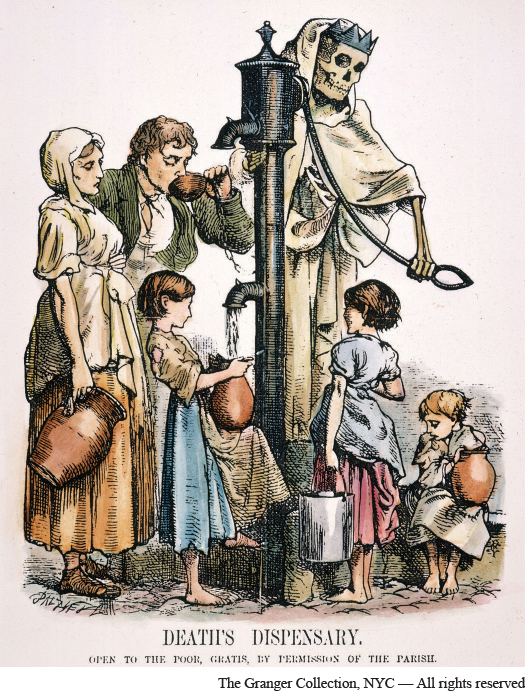The Laboring Classes
AP® EXAM TIP
How the Industrial Revolution affected the lower classes — for better and worse — is a very important topic in AP® World History.
The overwhelming majority of Britain’s nineteenth-
The lives of the laboring classes were shaped primarily by the new working conditions of the industrial era. Chief among those conditions was rapid urbanization. Liverpool’s population alone grew from 77,000 to 400,000 in the first half of the nineteenth century. By 1851, a majority of Britain’s population lived in towns and cities, an enormous change from the overwhelmingly rural life of almost all previous civilizations. By the end of the century, London was the world’s largest city, with more than 6 million inhabitants.

These cities were vastly overcrowded and smoky, with wholly insufficient sanitation, periodic epidemics, endless row houses and warehouses, few public services or open spaces, and inadequate and often-polluted water supplies. This was the environment in which most urban workers lived in the first half of the nineteenth century. By 1850, the average life expectancy in England was only 39.5 years, less than it had been some three centuries earlier. Nor was there much personal contact between the rich and the poor of industrial cities. Benjamin Disraeli’s novel Sybil, published in 1845, described these two ends of the social spectrum as “two nations between whom there is no intercourse and no sympathy; who are ignorant of each other’s habits, thoughts and feelings, as if they were dwellers in different zones or inhabitants of different planets.”
The industrial factories to which growing numbers of desperate people looked for employment offered a work environment far different from the artisan’s shop or the tenant’s farm. Long hours, low wages, and child labor were nothing new for the poor, but the routine and monotony of work, dictated by the factory whistle and the needs of machines, imposed novel and highly unwelcome conditions of labor. Also objectionable were the direct and constant supervision and the rules and fines aimed at enforcing work discipline. The ups and downs of a capitalist economy made industrial work insecure as well as onerous.
In the early decades of the nineteenth century, Britain’s industrialists favored girls and young unmarried women as employees in the textile mills, for they were often willing to accept lower wages, while male owners believed them to be both docile and more suitable for repetitive tasks such as tending machines. (See Zooming In: Ellen Johnston.) A gendered hierarchy of labor emerged in these factories, with men in supervisory and more skilled positions while women occupied the less skilled and “lighter” jobs that offered little opportunity for advancement. Nor were women welcome in the unions that eventually offered men some ability to shape the conditions under which they labored.
Thus, unlike their middle-class counterparts, many girls and young women of the laboring classes engaged in industrial work or found jobs as domestic servants for upper- and middle-class families to supplement meager family incomes. But after marriage, they too usually left outside paid employment because a man who could not support his wife was widely considered a failure. Within the home, however, many working-class women continued to earn money by taking in boarders, doing laundry, or sewing clothes in addition to the domestic and child-rearing responsibilities long assigned to women.